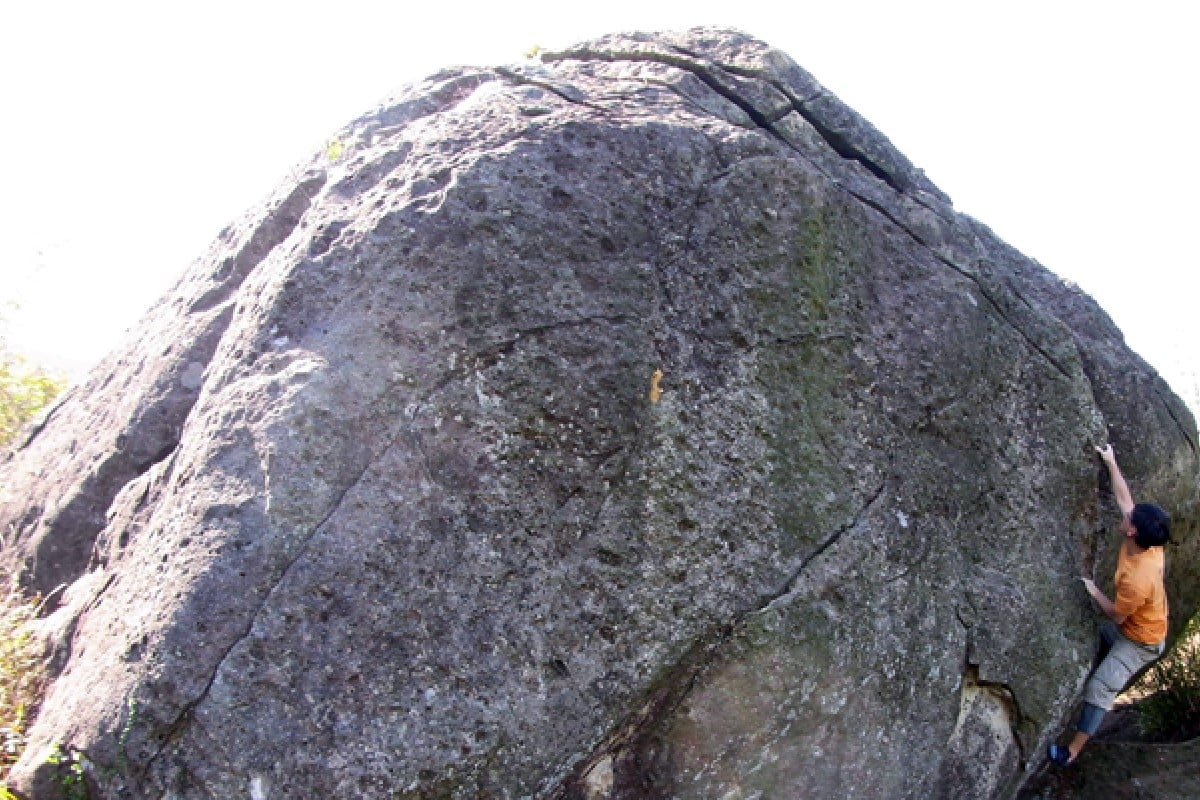
Outdoor Bouldering: there's more you can do in Hong Kong's hills than just hiking
Rock walls might not look like much, but they are the key to a fun kind of rock climbing called bouldering that doesn't require any fancy equipment
 Perry Tong doesn't take rocks for granted.
Perry Tong doesn't take rocks for granted.The greenery at Sunset Peak, the sea view from Dragon's Back and the sunrise from Lantau Peak are all familiar sights - every weekend social media is plastered with selfies of friends hiking all over Hong Kong. But if you're looking to do more with Hong Kong's hills than just walk on them, bouldering could be for you.
Bouldering is a form of rock climbing that doesn't require any ropes, harnesses or fixed gears. For protection, boulderers use a crash pad, a foam mat that is usually about 10cm thick. Perry Tong Kim-ming, who runs BoulderLand, a bouldering gym in Kwai Chung, says crash pads can protect falls from up to six metres high. Go any higher than that, though, and climbers risk facing significant injuries.
Compared to sport climbing - a type of rock climbing that relies on a series of permanent bolts and anchors to secure a rope to keep you safe - bouldering offers more room for freedom and creativity.
"In sport climbing, everyone has to follow the route that the bolter set. But when you boulder, you can climb routes on the same rock that other people have never done before, based on your ability and vision," says Tong.
While many bouldering spots in Hong Kong are included in guide books, Tong says there are still a lot of undiscovered places. He has been exploring various outdoor bouldering spots in Hong Kong for more than a decade, but is still looking for new routes in places like Tai Mo Shan and Tuen Mun. "I used to go hiking, and I would see some rocks in the distance that might be nice to climb. So I'd go back with some gardening cutting tools and make my way through to check them out," he says. Google Earth is also a useful tool to see if there are any rocks off the beaten track worth exploring. Once he reaches a rock, Tong clears off the vegetation covering it, checks for loose holds and comes up with potential routes.
Sometimes, though, a rock might be too eroded to climb. Hong Kong's boulders, which are granite, have been exposed for many years. Exposure to the sun and sea also speeds up erosion, causing holds to break off. Tong says that's why it's not easy to come across big hand-holds anymore.
In his expeditions, Tong has had numerous encounters with the local wildlife. "I've seen wild boars so big I thought they were cows. And there are snakes that are as thick as my arm," he says. His scariest memory was when a pack of wild dogs ran towards him. But even that wasn't able to discourage him from bouldering.
"I've tried many sports before - ball sports, biking, hiking - but none are as versatile as climbing. It's an ever-changing activity and no route is exactly the same. Every day is like day one," he says. "And although bouldering seems like a solo sport, you always go with other people. You build true friendships, because boulderers are very committed people and they trust each other to protect their lives."
Tips for beginners:
- Go with an experienced climber.
- Go to the well-established bouldering spots - it will be safer because most loose rocks will have been cleared away.
- Falling is inevitable, but be sure to maintain an upright body position, landing on both feet with your hands in front of you.
- Plan how you will get down from a rock before climbing it.
When to go:
It's best to go during autumn and winter, because Hong Kong summers are just too hot, and not all bouldering spots offer shade. If you really want to boulder outdoors during the summer, go to the more accessible locations after sunset - just bring a torch!
What to bring:
Climbing shoes to help you get better footing, chalk to keep your hands dry, a crash pad to land on, brushes to clear moss and insects off the rocks, cutting tools if you need to clear your path, a first-aid kit, snacks, and plenty of water.
Tong's top three climbing spots:
1 Tsuen Wan
Located on a hillside overlooking Tsuen Wan, Ha Fa Shan and Lin Fa Shan can be reached by a 30- and 60-minute walk, respectively, from Allway Gardens. The large number of rocks offer numerous routes: there are angled slabs and slant overhangs, as well as hand-holds of various types, so boulderers need to use a wide range of movements and techniques to solve the problems.
2 Shek O
Just 10 minutes east of Shek O village, the crags of Shek O are one of the most convenient bouldering spots in the city. They also offer a spectacular view of the beach. There are fewer overhanging routes here, although it can be just as challenging because of the smaller, sharper hand- and foot-holds. A number of restaurants are also close by and toilets are easily accessible.
3 Lamma Island
Lamma's rather far out, but once you actually get to the island it's an easy 20-minute walk to the Lik Kok Shan Boulders. Here, there are a lot of rounded hand-holds that are hard to cling on to. Because of this, it's also a good place to practise your top-out techniques - when you finish the route by standing on top of the rock. Many routes require pushing down on a ledge or feature instead of pulling yourself up. The panoramic sea-view is also hard to beat here.
For more information on routes, head to hongkongclimbing.com
